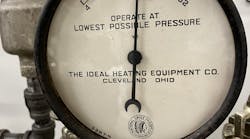Steam systems can be very quiet, gently heating cast iron radiators on a cold winter night. Steam systems can also be very loud, waking you up from a deep sleep on a cold winter night. This job was the latter. I had been offering advice on the phone to a contractor trying to help a homeowner. Banging pipes—what we call water hammer—was disturbing a family’s rest.
The contractor was passing the advice along to the homeowner and his brother-in-law, who lived in the basement of the house and consequently was front and center for the racket the system was making. There are many causes of water hammer in a residential steam heating system. Most are explained in my Field Guide in the chapter on returning water back to the boiler.
You can download a copy for free at the website steamupairoutwaterback.com. During most of my conversations with the contractor, I was driving down the road without access to the book and its troubleshooting charts.
How Clean is the Water?
The contractor would throw out a theory and we would discuss how it might apply to this project. The first thing that needs to be checked on any residential steam system is how clean is the water in the boiler. I am not talking about the color of the water, but whether it is free of “impurities.” What we are looking for is anything that ends up floating to the waterline to disrupt the release of steam bubbles.
The most common culprit is oil, which naturally floats to the surface and generally doesn’t mix with the water. (For more details, I covered this topic back in October 2020.) Oil contaminating the boiler water will cause a lot of different problems, so it is always smart to start with oil-free water in a steam boiler.
The homeowner’s brother-in-law is a handyman and the contractor didn’t want to send his guys for some reason, so he got the job of putting the cleaner in the boiler. The one we sell is color coded, green for good and red/pink for still dirty. You just add more cleaner until the color is right. Now we had a clean boiler making nice dry steam, but the same water hammer.
Check the Traps
The next thing I remember talking about was radiator traps. It is a two pipe system with radiator traps on each cast iron radiator. They were original to the house’s construction in the late 1920s. We agreed that a radiator trap that has failed open could allow steam into the dry return and cause problems.
The handy brother-in-law took on the job of replacing all of the elements in all of the radiator traps, since they were original and the homeowner was planning on staying in the house. If nothing else, it would improve efficiency and comfort. Unfortunately, that is all that replacing the elements did. Pow! The water hammer was still there.
Pipes out of Pitch?
Again, I was in the car driving when I got the news. Our conversation drifted to the pitch of the pipes and the condition of the wet return. Old houses sometimes settle, which can cause the pipes to come out of pitch. A steam system is based on the return of the condensate by pitch—water running downhill—or by vacuum. This system, like most residential systems, did not have a vacuum pump.
I told him it was time to throw a level on the pipes and get a look at the wet return. That’s the portion of the return piping that is below the waterline of the boiler and collects all the rust from the inside of the pipes and radiators. Over the years (and most residential steam systems are averaging over 100 years old) this accumulation builds up to block the return of water to the boiler. Besides causing water hammer, this slowing/blockage can also cause flooding.
The whole time we’re talking, I’m asking when the water hammer occurs. Does it happen at the beginning, middle or end of the steam cycle? Knowing this helps troubleshoot the problem. If it happens at the beginning, it could indicate that water is hung up by a sagging pipe. If it happens at the middle, it could indicate that water is stacking up into the steam main because of a clogged wet return. If it happens at the end of the cycle, it could indicate that the horizontal portion of the Hartford Loop is too long.
The answer was the beginning. But answers aren’t always correct. When we finally got to the point of a site visit, the system was as quiet as a church mouse. Just a gentle hiss from the multiple air vents. Air was passing freely from the system as the steam was moving through the pipes and up to the radiators. We double checked the pitch, observed the level in the gauge glass moving normally, and confirmed that the wet return was replaced with the last boiler replacement.
My Favorite Gauge
Fortunately, the boiler had a steam gauge that read between zero to fifteen pounds. That gauge is not the gauge in the picture, however. That is my favorite steam gauge in my collection because it states very clearly what steam pressure the system should be operating at. Unfortunately, the gauge scale assumes the reader knows it is indicating in ounces of pressure, not pounds, to the right of zero.
Also, it assumes the reader knows that it is indicating inches of water column of vacuum to the left of zero. Vacuum was important in the early days of coal fired equipment, but that is a topic for another column. The point is to keep your operating pressure very low. Many residential steam systems were designed as vapor, with an operating pressure of only eight ounces.
With a lower operating steam pressure, the vertical distance between the water line and the horizontal steam main and dry return could be reduced. No more digging a pit to set the boiler in to increase that distance. In this house, the boiler is set on the basement floor and the ceiling was normal height.
Vaporstat to the Rescue
When the boiler got up to two pounds of pressure, the noise began. For every pound of steam pressure, there has to be 28” of vertical distance to create the pressure necessary to push the water back in the boiler by gravity. At two pounds the distance has to be at least 56”. We measured the vertical distance between the water line and the horizontal pipes at less than the necessary 56”.
Once the problem was identified, the solution became clear. Replace the conventional pressure control that is scaled in pounds to a pressure control that is scaled in ounces, generally referred to as a vaporstat. Adjust the new control to 12 ounces or so, and the system will stay quiet, like it’s supposed to.
Patrick Linhardt is a thirty-nine-year veteran of the wholesale side of the hydronic industry who has been designing and troubleshooting steam and hot water heating systems, pumps and controls on an almost daily basis. An educator and author, he is currently Hydronic Manager at the Corken Steel Products Co.


